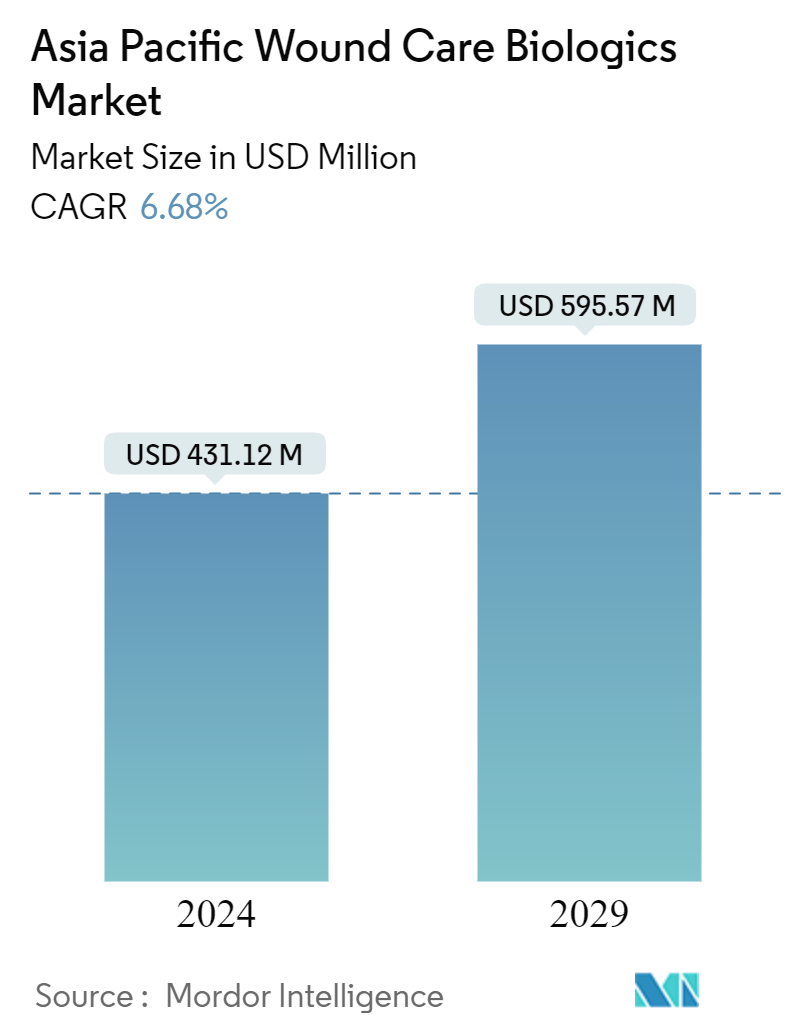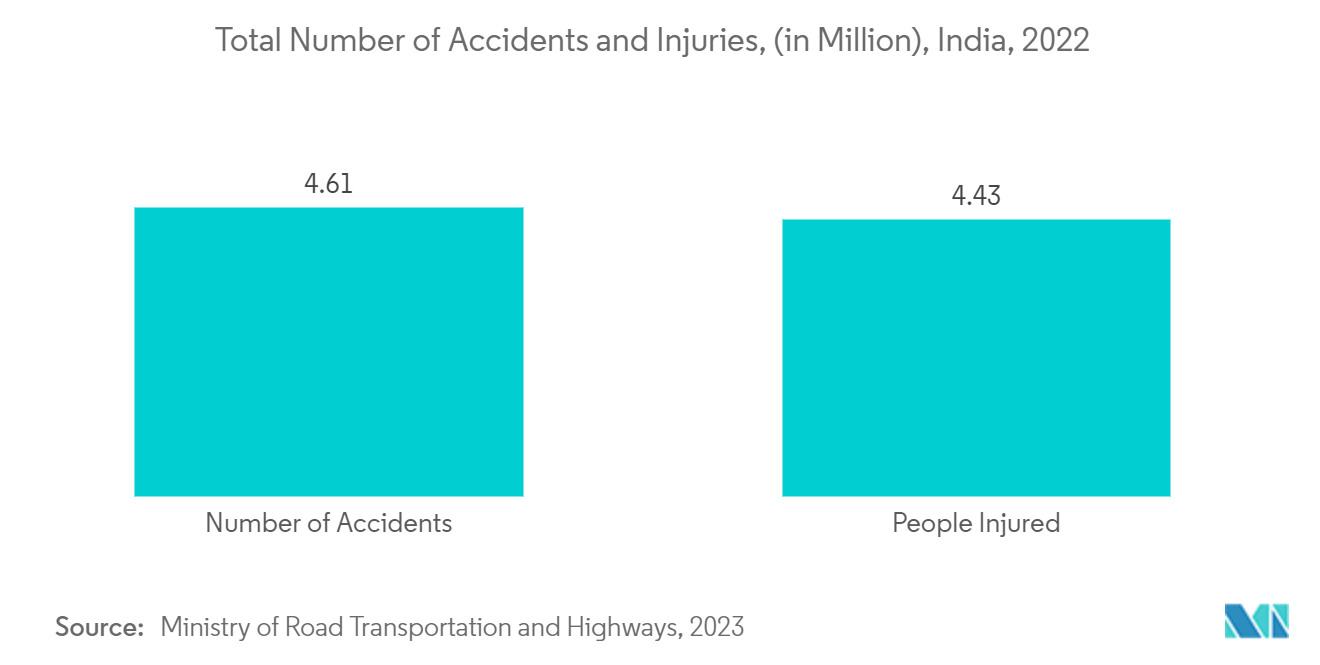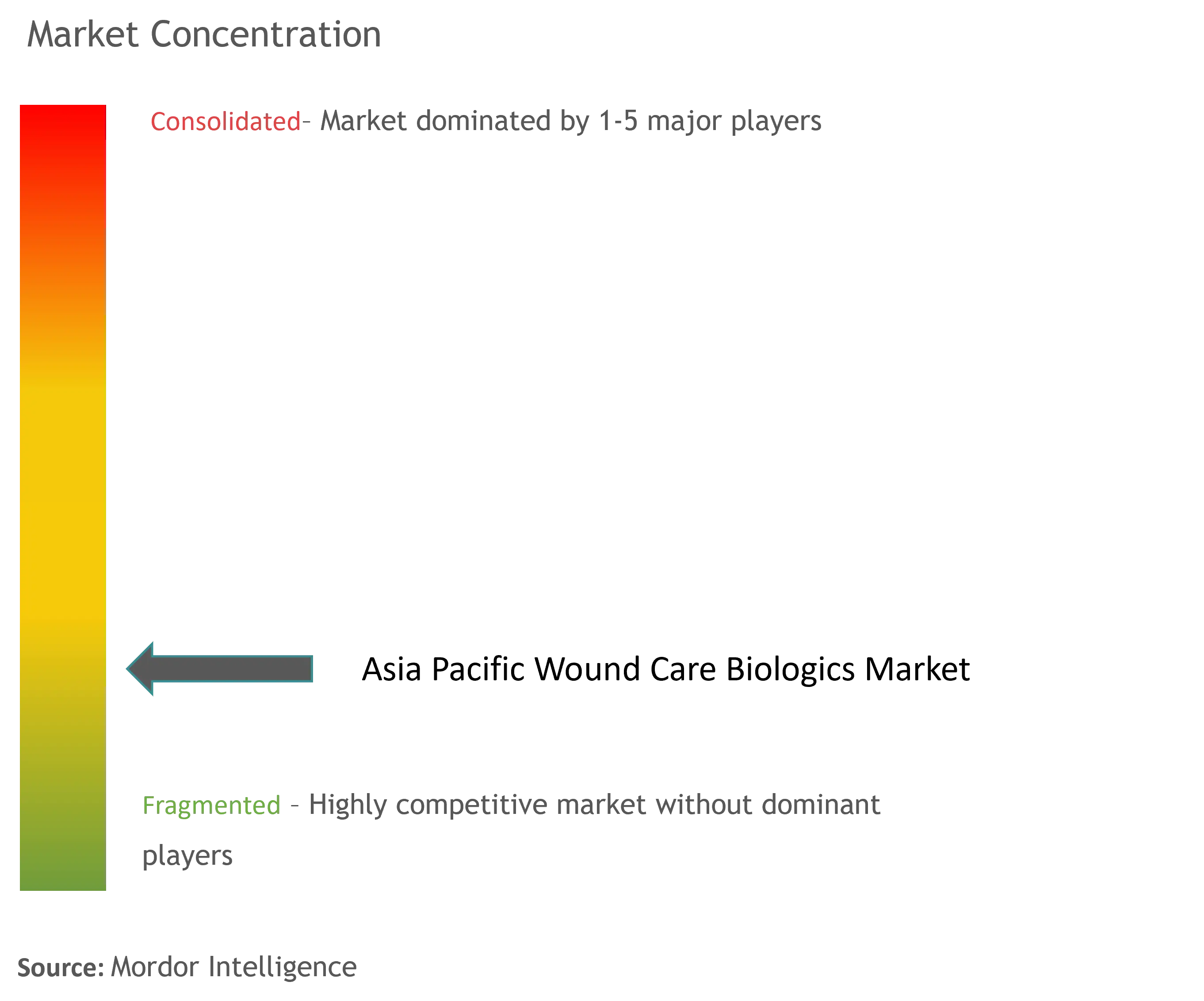Asia Pacific Wound Care Biologics Market Size

| Study Period | 2019 - 2029 |
| Base Year For Estimation | 2023 |
| Market Size (2024) | USD 431.12 Million |
| Market Size (2029) | USD 595.57 Million |
| CAGR (2024 - 2029) | 6.68 % |
| Market Concentration | Low |
Major Players.webp)
*Disclaimer: Major Players sorted in no particular order |
Asia Pacific Wound Care Biologics Market Analysis
The Asia Pacific Wound Care Biologics Market size is estimated at USD 431.12 million in 2024, and is expected to reach USD 595.57 million by 2029, growing at a CAGR of 6.68% during the forecast period (2024-2029).
The factors driving the growth of the wound biologics market are the rising chronic wound prevalence, including pressure ulcers and diabetic foot ulcers, increasing road accidents, and the presence of several players and their strategic initiatives, such as collaborations, partnerships, and mergers and acquisitions.
The prevalence of traffic accidents and the resulting injuries influence the Asia-Pacific wound care biologics market. According to the article published by the Nippon Communications Foundation in January 2024, traffic accidents increased by 7,072 in Japan to 307 thousand incidents in 2023. Moreover, the number of people injured in these accidents rose to 365 thousand, marking an increase of 8,426 individuals. As the burden of traffic-related injuries continues to rise, there is a growing imperative to invest in advanced biologic therapies and innovative treatment modalities to address the complex needs of wound care effectively.
The rising incidence of chronic wounds and advancements in biotechnology drive the market's growth. For instance, in May 2023, an article published by the National Institute of Health reported that the proportion of patients requiring hospitalization due to chronic wounds was 1.7% in China, mainly among people aged 40-60 years (31%) and 60-80 years (38%). The leading causes of chronic wounds are diabetes, traumatic and pressure injuries, etc. Thus, a rise in chronic wounds would drive the demand for the wound care biologics market in the country.
Government initiatives in wound care are poised to significantly boost market growth. In March 2024, Wounds Australia and the Australian College of Nursing (ACN) secured grants from the Commonwealth of Australia. These grants aim to support innovative projects that enhance the comprehension of wound care, targeting both healthcare professionals and the wider community. Notably, Wounds Australia is set to receive a substantial AUD 2 million (USD 1.44 million) to spearhead a nationwide campaign focused on educating and raising awareness about chronic wound prevention and treatment. Increasing awareness of the treatment is likely to enhance the requirement for biologics wound care, resulting in market growth over the forecast period.
Hence, the growing incidence rate of road accidents, coupled with growing chronic wounds and awareness programs, will likely accelerate the requirement for biologics wound care, resulting in market growth. However, the regulatory challenges and high costs associated with biologics are expected to restrict the demand for wound care biologics.
Asia Pacific Wound Care Biologics Market Trends
The Diabetic Foot Ulcers Segment Is Expected to Hold a Significant Market Share During the Forecast Period
Diabetic foot ulcers (DFUs) are a significant and often debilitating complication of diabetes, affecting millions of individuals in Asia. As the prevalence of diabetes continues to rise, so does the burden of DFUs, creating an urgent need for effective treatments within the wound care biologics market.
Diabetic foot ulcers are chronic, non-healing wounds that typically develop on the feet or lower extremities of individuals with diabetes. These ulcers are caused by a combination of factors, including poor circulation, nerve damage (neuropathy), and impaired immune function, leading to delayed healing and an increased risk of infection. DFUs are a major cause of hospitalization, amputation, and reduced quality of life among diabetic patients.
The expanding market for wound care biologics targeting diabetic foot ulcers (DFUs) is intricately connected to the increasing prevalence of diabetes. For instance, a publication in the Journal of Diabetology in November 2023 highlighted that according to the International Diabetes Federation Atlas, a staggering 537 million adults globally had diabetes, with Asia alone contributing to 60% of this population. Projections suggest a 68% increase in diabetes prevalence in Southeast Asia by 2045.
A study published by the American Medical Association in November 2023 revealed that one-third of individuals with diabetes developed foot ulcers at some point in their lives. With the diabetes epidemic intensifying, there is a corresponding anticipation of heightened demand for effective treatments for DFUs.
Biologics, which are medical products derived from living organisms, have emerged as a promising avenue for treating DFUs. These innovative therapies aim to promote wound healing by addressing the underlying cellular and molecular mechanisms involved in the healing process. For instance, in May 2023, Stempeutics Research reported progress in their Phase 3 clinical trial for Stempeucel-DFU, an allogeneic mesenchymal stromal cell product candidate. The trial, which completed enrollment, evaluates the efficacy of a single peri-ulcer injection administered through various routes based on the location of the ulcer. The Drugs Controller General of India (DCGI) approved this Phase 3 trial, highlighting the significant potential of biologics in the treatment of DFUs.
As the prevalence of diabetes continues to rise, the burden of diabetic foot ulcers is expected to increase correspondingly, hence boosting segmental growth over the forecast period.

India is Expected to Hold a Significant Market Share Over the Forecast Period
India, with its burgeoning population and increasing incidences of accidents and burns, plays a pivotal role in shaping the wound biologics care market in Asia. As the country grapples with the challenges of managing wounds effectively, there is a growing recognition of the importance of innovative biological solutions.
India's significant share of the market is underpinned by the alarming prevalence of burn cases and road accidents. According to an article published by Cureus Inc. in February 2024, the country witnesses an estimated 6-7 million burn cases annually. Factors contributing to this high incidence included socioeconomic issues such as illiteracy, poverty, and limited awareness of safety measures. The problem was compounded by inadequate systematic burn care at basic and secondary healthcare levels, exacerbating the burden on healthcare infrastructure.
The Ministry of Road Transport and Highways' Road Accidents in India report highlights the country's escalating number of road accidents. In 2022 alone, 461 thousand road accidents were reported, marking an 11.9% increase compared to the previous year. These accidents not only result in physical injuries but also often lead to severe wounds requiring advanced medical intervention.
Amidst these challenges, there are promising developments in the field of wound management in India. An article published by Global Surgery Research in September 2023 reported a significant milestone, with the India Hub training over 500 practitioners in wound management. This underscored a concerted effort to enhance expertise and capabilities in addressing the complex needs of wound care across the country.
The wound biologics care market in India is likely to witness significant growth with the increasing burden of burn cases and road accidents, raising the requirement for wound biologics care over the forecast period.

Asia Pacific Wound Care Biologics Industry Overview
The Asia-Pacific wound care biologics market is fragmented. The key market players include Smith+Nephew, 3M Company, Integra LifeSciences, Cardinal Health and Convatec Inc.. The key players are adopting various strategies such as product launches, expansion of the products and services into new regions, mergers and acquisitions, partnerships, and collaborations to strengthen their position in the market.
Asia Pacific Wound Care Biologics Market Leaders
-
Smith+Nephew
-
Integra LifeSciences
-
Convatec Inc.
-
Mölnlycke Health Care AB
-
3M
*Disclaimer: Major Players sorted in no particular order

Asia Pacific Wound Care Biologics Market News
- February 2024: The Tokyo University of Science unveiled a cutting-edge wound treatment gel that harnesses the power of seaweed and carbonated water. This innovative hydrogel accelerates wound healing significantly and prevents the common issue of temporary wound site dilation, a drawback often seen in traditional gels. These promising outcomes pave the way for the future clinical adoption of eco-friendly and potent therapeutic gels.
- June 2023: The Manipal Center for Interprofessional Advanced Wound Care, affiliated with Coloplast India, collaborated with the Manipal College of Nursing (MCON) to conduct a successful two-day hands-on workshop. The workshop was aimed at enhancing the skills of staff nurses, MBBS graduates, and nursing students in advanced wound care. The workshop encouraged the sharing of best practices and knowledge among healthcare professionals, fostering a collaborative approach to improve patient outcomes.
Asia Pacific Wound Care Biologics Market Report - Table of Contents
1. INTRODUCTION
1.1 Study Assumptions and Market Definition
1.2 Scope of the Study
2. RESEARCH METHODOLOGY
3. EXECUTIVE SUMMARY
4. MARKET DYNAMICS
4.1 Market Overview
4.2 Market Drivers
4.2.1 Growing Burden of Burn Injuries and Road Accidents
4.2.2 Government Initiatives Regarding Wound Care Treatment
4.3 Market Restraints
4.3.1 High Treatment Cost
4.3.2 Stringent Regulatory Guidelines and Challenges Faced by the Manufacturers
4.4 Porter's Five Forces Analysis
4.4.1 Threat of New Entrants
4.4.2 Bargaining Power of Buyers/Consumers
4.4.3 Bargaining Power of Suppliers
4.4.4 Threat of Substitute Products
4.4.5 Intensity of Competitive Rivalry
5. MARKET SEGMENTATION (Market Size by Value - USD)
5.1 By Product
5.1.1 Biological Skin Substitutes
5.1.2 Topical Agents
5.2 By Wound Type
5.2.1 Ulcers
5.2.1.1 Diabetic Foot Ulcers
5.2.1.2 Venous Ulcers
5.2.1.3 Pressure Ulcers
5.2.1.4 Other Ulcers
5.2.2 Surgical and Traumatic Wounds
5.2.3 Burns
5.3 By End User
5.3.1 Hospitals/Clinics
5.3.2 Ambulatory Surgical Centers
5.3.3 Other End Users
5.4 Geography
5.4.1 China
5.4.2 Japan
5.4.3 India
5.4.4 Australia
5.4.5 South Korea
5.4.6 Rest of Asia-Pacific
6. COMPETITIVE LANDSCAPE
6.1 Company
6.1.1 Smith+Nephew
6.1.2 3M
6.1.3 Integra LifeSciences
6.1.4 Cardinal Health
6.1.5 Convatec Inc.
6.1.6 Molnlycke Health Care AB
6.1.7 Axio Biosolutions Pvt Ltd
6.1.8 Centaur Pharmaceuticals
6.1.9 B. Braun Melsungen AG
6.1.10 Cuprina Holdings Pte. Ltd
Asia Pacific Wound Care Biologics Industry Segmentation
As per the report, wound care biologics refer to products that control and heal infections. Wound healing is a complex process involving inflammation, accumulation of tissue, deposition of collagen, and formation of epithelial cell layers.
The Asia-Pacific wound care biologics market is segmented by product, wound type, end user, and country. By product, the market is segmented into biologic skin substitutes and topical agents. By wound type, the market is segmented into ulcers, surgical and traumatic wounds, and burns. By ulcers, the market is segmented into diabetic foot ulcers, venous ulcers, pressure ulcers, and other ulcers. By end user, the market is segmented into hospitals/clinics, ambulatory surgical centers, and other end users. By country, the market is segmented into China, Japan, India, Australia, South Korea, and the Rest of Asia-Pacific. The report offers market sizes and forecasts for all the above segments in terms of value (USD).
| By Product | |
| Biological Skin Substitutes | |
| Topical Agents |
| By Wound Type | ||||||
| ||||||
| Surgical and Traumatic Wounds | ||||||
| Burns |
| By End User | |
| Hospitals/Clinics | |
| Ambulatory Surgical Centers | |
| Other End Users |
| Geography | |
| China | |
| Japan | |
| India | |
| Australia | |
| South Korea | |
| Rest of Asia-Pacific |
Asia Pacific Wound Care Biologics Market Research FAQs
How big is the Asia Pacific Wound Care Biologics Market?
The Asia Pacific Wound Care Biologics Market size is expected to reach USD 431.12 million in 2024 and grow at a CAGR of 6.68% to reach USD 595.57 million by 2029.
What is the current Asia Pacific Wound Care Biologics Market size?
In 2024, the Asia Pacific Wound Care Biologics Market size is expected to reach USD 431.12 million.
Who are the key players in Asia Pacific Wound Care Biologics Market?
Smith+Nephew, Integra LifeSciences, Convatec Inc., Mölnlycke Health Care AB and 3M are the major companies operating in the Asia Pacific Wound Care Biologics Market.
What years does this Asia Pacific Wound Care Biologics Market cover, and what was the market size in 2023?
In 2023, the Asia Pacific Wound Care Biologics Market size was estimated at USD 402.32 million. The report covers the Asia Pacific Wound Care Biologics Market historical market size for years: 2019, 2020, 2021, 2022 and 2023. The report also forecasts the Asia Pacific Wound Care Biologics Market size for years: 2024, 2025, 2026, 2027, 2028 and 2029.
Asia Pacific Wound Care Biologics Industry Report
Statistics for the 2024 Asia Pacific Wound Care Biologics market share, size and revenue growth rate, created by Mordor Intelligence™ Industry Reports. Asia Pacific Wound Care Biologics analysis includes a market forecast outlook for 2024 to 2029 and historical overview. Get a sample of this industry analysis as a free report PDF download.



